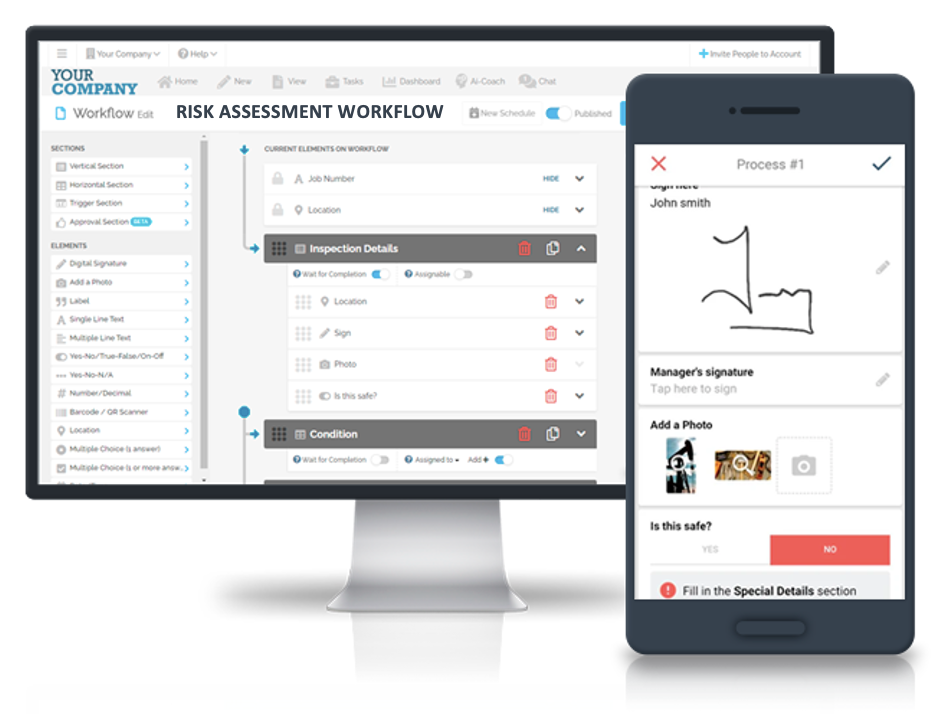Key Takeaways
- HSE standards protect workers and the environment in the oil industry.
- Compliance challenges include regulatory complexity and human error.
- Digital solutions like FAT FINGER automate HSE processes and improve accuracy.
- Proactive risk management helps prevent accidents and reduces downtime.
- Integrating safety with sustainability is a growing priority in the industry.
Health, Safety, and Environment (HSE) in the Oil Industry
The oil industry is one of the most hazardous sectors globally, with significant risks to health, safety, and the environment (HSE). Ensuring robust HSE practices is not just a regulatory requirement but a moral and operational imperative.
This article delves into the critical role of HSE in the oil industry, supported by relevant examples, case studies, and statistics. We will also explore how digital solutions like FAT FINGER can enhance HSE practices through powerful safety checklists.
Request a demo today to see how FAT FINGER can transform your HSE protocols.
The Importance of HSE in the Oil Industry
Health, Safety, and Environment (HSE) are crucial components in the oil industry due to the high-risk nature of operations. From drilling to transportation, each phase poses unique challenges that can lead to catastrophic consequences if not managed properly.
Health Risks
Workers in the oil industry are exposed to various health risks, including exposure to hazardous chemicals, extreme temperatures, and physical injuries. Chronic exposure can lead to long-term health issues such as respiratory problems and skin diseases.
Safety Concerns
Safety is a paramount concern in the oil industry. Accidents such as explosions, fires, and oil spills can result in significant loss of life and property. For instance, the Deepwater Horizon disaster in 2010 resulted in 11 fatalities and extensive environmental damage.
Environmental Impact
The environmental impact of oil operations is profound. Oil spills, gas flaring, and waste disposal can lead to severe ecological damage. The Exxon Valdez oil spill in 1989 is a stark reminder of the long-term environmental consequences of inadequate HSE practices.
Key Components of HSE Management

Effective HSE management involves several key components that work together to mitigate risks and ensure compliance with regulatory standards.
Risk Assessment
Risk assessment is the cornerstone of HSE management. It involves identifying potential hazards, evaluating the risks associated with them, and implementing measures to mitigate those risks. Regular risk assessments help in proactively addressing potential issues before they escalate.
Training and Awareness
Training and awareness programs are essential for equipping employees with the knowledge and skills to handle HSE challenges. Regular training sessions ensure that workers are aware of the latest safety protocols and best practices.
Emergency Response Planning
Emergency response planning is crucial for minimizing the impact of accidents. A well-structured emergency response plan ensures that all stakeholders know their roles and responsibilities in the event of an emergency.
The Role of Digital Solutions in Enhancing HSE

In today’s digital age, technology plays a pivotal role in enhancing HSE practices. Digital solutions like FAT FINGER offer powerful tools to streamline HSE processes and ensure compliance.
Take 5 Safety
The Take 5 Safety checklist on FAT FINGER helps workers perform quick safety checks before starting any task. This proactive approach ensures that potential hazards are identified and mitigated early.
Near Miss Reporting
Near miss reporting is crucial for identifying potential hazards that could lead to accidents. FAT FINGER’s Near Miss Reporting checklist allows workers to report near misses easily, enabling organizations to take corrective actions promptly.
Job Hazard Analysis
Job Hazard Analysis (JHA) involves identifying and evaluating hazards associated with specific tasks. FAT FINGER’s JHA checklist simplifies this process, ensuring that all potential risks are assessed and mitigated.
Risk Assessment
FAT FINGER’s Risk Assessment checklist provides a structured approach to identifying and evaluating risks. This tool helps organizations implement effective risk mitigation measures, ensuring a safer work environment.
Incident Reporting in the Workplace
Incident reporting is essential for documenting accidents and identifying their root causes. FAT FINGER’s Incident Reporting checklist streamlines this process, ensuring that all incidents are reported and investigated thoroughly.
Journey Report
The Journey Report checklist on FAT FINGER helps organizations monitor and manage the safety of transportation activities. This tool ensures that all journeys are planned and executed safely, minimizing the risk of accidents.
Statistics: The Impact of HSE Practices
Statistics highlight the significant impact of effective HSE practices in the oil industry.
- According to the International Association of Oil & Gas Producers (IOGP), companies with robust HSE practices have a 50% lower incident rate compared to those with inadequate HSE measures.
- The Occupational Safety and Health Administration (OSHA) reports that effective HSE practices can reduce workplace injuries by up to 40%.
- A study by the American Petroleum Institute (API) found that companies investing in HSE practices see a 20% improvement in operational efficiency.
Conclusion
Health, Safety, and Environment (HSE) are critical components in the oil industry, ensuring the well-being of workers and the protection of the environment. Effective HSE management involves risk assessment, training, and emergency response planning.
Digital solutions like FAT FINGER offer powerful tools to enhance HSE practices through safety checklists such as Take 5 Safety, Near Miss Reporting, Job Hazard Analysis, Risk Assessment, Incident Reporting in the Workplace, and Journey Report. By leveraging these tools, organizations can significantly improve their HSE performance, ensuring a safer and more efficient work environment.
Create a safety workflow for free on FAT FINGER or request a demo today to see how FAT FINGER can transform your HSE protocols.
FAQs About Health, Safety, and Environment (HSE) in the Oil Industry
Q: Why are HSE standards critical in the oil industry?
HSE standards protect workers, reduce accidents, and minimize environmental harm.
Q: What are the main challenges in implementing HSE standards?
Complex regulations, real-time monitoring issues, and human error are common challenges.
Q: How can digital solutions improve HSE compliance?
Digital tools automate workflows, reduce errors, and ensure real-time compliance.
Q: What is proactive risk management, and how does it benefit oil companies?
It identifies risks before incidents occur, preventing accidents and reducing costs.
Q: How does sustainability factor into HSE practices in the oil industry?
Sustainability is increasingly integrated to reduce environmental impact and meet standards.

